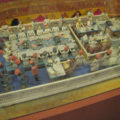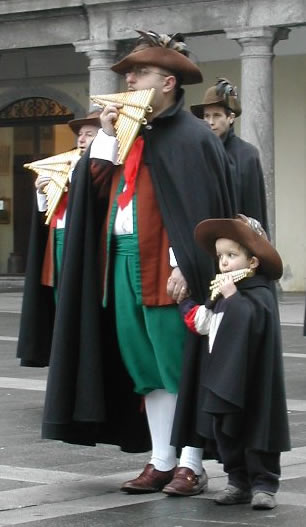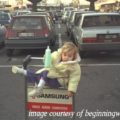Hackneys and others reminisce about children’s games and scorpions. Filmed at the Woodstock Old Students’ Association (North America) 2003 reunion
Paul Hackney: Learning About India
filmed at the Woodstock Old Students’ Association (North America) 2003 reunion
Paul reminisces about what he learned about Indian culture from Indian friends and neighbors.
More Woodstock Videos
House-Moving in Italy
We couldn’t have picked a worse time to move: record high temperatures and humidity, with people literally falling down in the streets. In a particularly horrible accident the other day, a man on a street repair crew fainted. His colleague driving the tar truck didn’t see him on the ground, and backed over him.
Our move has been far less dramatic, but involves lots of hard work and running around when we’d be wiser to take a siesta. When you rent an apartment in Italy, unless it’s advertised as “furnished,” it’s completely bare: no kitchen appliances, no light fixtures. (Toilets and showers yes, at least, but often no toilet seats.) So everyone buys and/or moves their own major appliances, and we’re taking the opportunity to upgrade our kitchen. Our old kitchen in Milan is literally one meter by two – I’ve seen bigger walk-in closets. When we moved here, we had to measure carefully to ensure that the stove and a (clothes) washing machine would fit in beside the sink. I am so thrilled now to have a huge, eat-in kitchen, even though it’s tiled (floor and walls) in a bilious shade of olive green that was popular around 1975. We’ve brought up some pieces from my in-laws’ place in Rome: a painted wood table, sideboard, and display dish rack which also happen to be olive green (decorated with flowers and birds, which is not as bad as sounds). I’ve never been particularly fond of these pieces, but they go very nicely in the olive green kitchen.
Our own kitchen stuff (which, in Milan, is in the living/dining room) is made of a light-colored wood (from Ikea), so we’re adding more pieces in that style to expand storage and work space. For the last 12 years I’ve been producing culinary miracles on a 40×60 cm worktop. Can’t wait to see what I’ll be able to do with a REAL kitchen.
So the upside is that we get to do our own kitchen. The downside is that we have to, and it’s still not in working order. Figuring out what would fit where, making buying decisions, and having things delivered and installed, is taking far more time than I expected. Getting workmen to come is proving difficult. The electrician never showed up for our appointment last Friday, and has since been impossible to reach on his cellphone. Hit by a truck? (If not, he’s about to wish had been…) At least the plumber has been reliable, and hopefully will be able to find his carpenter friend to come Monday, because there’s a worktop that will need to be cut for the sink…
We’ll move the last major stuff from Milan on Sunday, and will bring up our handyman to attach bookshelves to walls and hang paintings. I always knew Signor Gino was a treasure; I just hadn’t realized he was an irreplaceable treasure – so far we haven’t managed to find anyone in Lecco to do this sort of thing. We’ve got zillions of books sitting around in boxes because I can’t put them on the shelves yet, which is making me crazy.
Yesterday, in frustration, I vowed that I would learn to use a power drill myself, so that in future I can make my own holes in the wall. As a start, I went to the hardware department at the local Bennet (Italian Wal-Mart). After half an hour of browsing, I realized that I am indeed a complete geek: I was enjoying looking at tools, electrical connectors, wire… I bought a wire stripper, and am determined to use it! So I’ll be watching Gino closely on Sunday to see how he does all this stuff, and from here on I will be a do-it-yourselfer.
Oh, and one slight detail: I want everything done before I take off for Boston on July 4th!
Italian Brats
A survey cited by Zoomata says “a recent poll of 2,500 travel-industry professionals voted Italian kids the most obnoxious and unruly in the EU. … according to UNICEF, only 50% of parents [in Italy] reprimand their kids.”
I’d have to agree that many Italian parents are over-indulgent with their kids, and many young Italian children noticeably lack discipline and common courtesy. At my daughter’s riding school, I waged a never-ending battle to keep other people’s kids from running amok and scaring the horses during lessons. (Horses scare easily, and when they do, their riders often fall.)
This led to some surprising run-ins with small children. One three-year-old not only would not stop making noise, but gave me lip when I asked him to:
Me: “Stop that. You’ll scare the horses and someone could fall.”
Him: “I don’t care.”
Me: “Someone could get hurt!”
Him: “I don’t care. Anyway, it doesn’t hurt to fall.”
Me: “Oh, yes, it does. Want me to show you?”
Another child, when I asked him to be quieter, said “No.”
I asked: “Where’s your mother?”
“I’m not going to tell you.”
So I tucked him under my arm and carried him off to find her, to general astonishment. At least I resisted the very strong urge to spank him!
The teacher in my daughter’s elementary school put up with far worse. One boy called her a whore. She pretended not to hear, which surprised me. I’ve attended many schools, and in every one of them, that would have got the kid sent to the principal’s office, or suspended.
Raising a Bilingual Child
Our daughter is bilingual in English and Italian, and some people have asked “how we did it.” There really wasn’t much to it. While I was pregnant, I read the only book I could find on the subject (The Sun is Feminine Amazon UK | US), which happened to be written (in English) by a German linguist married to an Italian. She suggested following the “one parent, one language” rule: each parent should speak only one language (preferably his or her native one) with the child, right from birth, so that the child is able to identify each language with a specific person, and thereby learns to keep the languages separate.
So that’s what we did. For the first 15 months of her life, Ross was mostly in the US, from then on she was mostly in Italy, but, wherever we were, I addressed her only in English, Enrico only in Italian. Enrico and I communicated in English, as a matter of habit – I didn’t speak Italian when I first met him! But when we were with Italian speakers I spoke Italian, and Ross heard me doing it. So by age three she decided that, while she could understand English perfectly well, there was no need for her to go to the effort of speaking it, since it was obvious that everybody understood Italian. I would always speak English to her, and she’d always reply in Italian. Heads would turn on the street as people tried to understand what was going on.
The summer she turned four, we took her on a trip to other parts of Europe, visiting various friends. One couple were English and German, raising their own bilingual kids in Germany. Rossella realized that she had to speak English to be understood by these adults, but for some reason she remained convinced that all children spoke Italian. My friend’s son, the same age, was similarly convinced that all kids must speak German. They struggled for days to communicate, until Ross finally said to him, in great frustration: Ma tu devi parlare inglese! (“But you have to speak English!”)
We didn’t have a TV for the first couple of years we were in Milan; we got one around Ross’ third year so that she could hear more English, on videotape. We got a multistandard VCR so we could watch films imported from the US, and built up an impressive collection of Disney movies. (Fortunately, Enrico and I liked them, too.)
If Ross were growing up in the US, it would probably be difficult to get her to speak Italian. Many American schoolkids don’t value the ability to speak a foreign language, and of course no child wants to be observed doing something uncool or different. But, in Italy, she gets lots of positive reinforcement for being bilingual. When she was in elementary school, her friends’ parents used to say: “Go play with Rossella and learn some English!” And everyone tells her how lucky she is to speak it so well.
We know several other multilingual families, and it’s interesting to observe which language the kids will drop into, depending on environment or what they’re talking about. In one family we know, she’s a multilingual Italian (speaks Italian, English, French, and Spanish fluently), he’s German. Between them they communicate in English, the only language they have in common. He speaks only German to the kids, she only Italian. So they hired an English-speaking nanny, and the kids are trilingual. Another couple are Americans whose kids were born in Italy, attended Italian schools, and spoke English at home. The parents sometimes spoke French as their “secret” language when they wanted the kids not to understand something, which motivated the kids to learn French! (Ross has been taking French in school; many schools offer English and a choice of French or German.)
It’s no longer necessary to maintain linguistic purity for Ross’ sake, so our family language has become an idiosyncratic mix that still causes heads to turn. I was wondering recently why people stare at Ross and me in the subway when we speak English; English speakers are not rare in Milan. Then I realized that they’re probably staring because we’re not speaking pure English; we blend it freely with Italian, especially when talking about activities that take place in Italian, such as riding or school.
Being bilingual has disadvantages. I sometimes realize after the fact that I’ve said or written something that was far too literal a translation from one language or the other. An American friend, who’s been in Italy even longer than I, once said to me: “I’ll make a jump at the new house on my way back.” This sounded weird in a way that I couldn’t immediately put my finger on. Then I realized that she had translated literally the Italian “Faro’ un salto;” Italians use “make a jump” the way English speakers use “stop by.” That’s what she meant and what I, being fluent in both languages, heard. Anyone who wasn’t bilingual in English and Italian would have been thoroughly confused.













